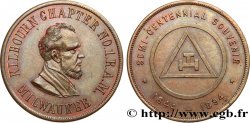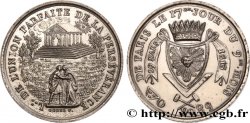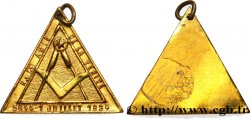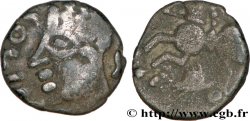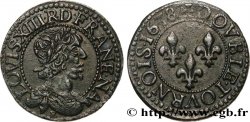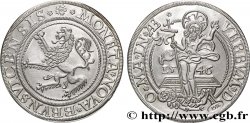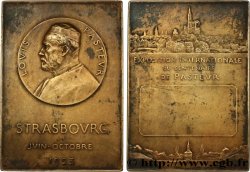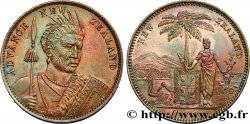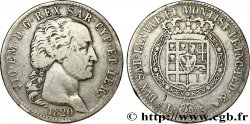v19_1086 - FREEMASONRY Jeton Ar 31, Orient de Paris, loge de Saint Antoine du parfait contentement (1785)
MONNAIES 19 (2004)
Starting price : 230.00 €
Estimate : 380.00 €
Realised price : 268.00 €
Number of bids : 2
Maximum bid : 385.00 €
Starting price : 230.00 €
Estimate : 380.00 €
Realised price : 268.00 €
Number of bids : 2
Maximum bid : 385.00 €
Type : Jeton Ar 31, Orient de Paris, loge de Saint Antoine du parfait contentement
Date: 5785
Date: (1785)
Mint name / Town : Paris
Metal : silver
Diameter : 31,5 mm
Orientation dies : 12 h.
Weight : 11,31 g.
Edge : cannelée
Rarity : R2
Coments on the condition:
Patine sombre avec une tache claire au droit, à trois heures. Au revers, splendide patine aux reflets mordorés sur le brillant d’origine
Obverse
Obverse legend : [LOGE] ST. ANTOINE:. DU:. PARFAIT:. CONTENTEMENT:. .
Obverse description : Un autel sur lequel est posé une épée et les tables de la Loi et entouré de deux branches d’olivier surmontées du soleil et de la lune visagés ; au-devant de l’autel un compas et une équerre posé sur un coussin ; à l’exergue : 5785.
Reverse
Reverse legend : ACCROISSEMT. DE L’ORDRE.
Reverse description : Un homme en toge romaine, les yeux bandés, conduit par une main sortant d’un nuage vers un temple à quatre colonnes bordé d’acacias ; à l’exergue : O:. DE:. PARIS.
Commentary
Ce jeton est peut-être une frappe d’origine mais plus vraisemblablement de l’époque du Premier Empire.
La franc-maçonnerie s’implante en France aux alentours du premier quart du XVIIIe s. sous l’influence d’aristocrates anglais. Initiatique, elle est fondée sur le rite hiramique, du nom d’Hiram de Tyr, personnage biblique, architecte du roi Salomon sur le chantier du Temple et qui a résisté à la torture sans livrer ses secrets. Hiram a aussi donné un point de départ du calendrier maçonnique commençant 4000 ans avant le calendrier chrétien. Les symboles servent de signes de reconnaissance entre les initiés, notamment des outils de constructeur de cathédrales (équerre, compas, niveau, maillet, etc.), des formes (triangle, étoile), des nombres (trois, cinq, sept) et des lettres.
This token may be an original strike, but more likely from the time of the First Empire. Freemasonry was established in France around the first quarter of the 18th century under the influence of English aristocrats. Initiatory, it is based on the Hiramic rite, named after Hiram of Tyre, a biblical figure, architect of King Solomon on the construction site of the Temple, who resisted torture without revealing his secrets. Hiram also provided a starting point for the Masonic calendar, which began 4,000 years before the Christian calendar. Symbols serve as signs of recognition between initiates, including cathedral builder's tools (set square, compass, level, mallet, etc.), shapes (triangle, star), numbers (three, five, seven), and letters.
La franc-maçonnerie s’implante en France aux alentours du premier quart du XVIIIe s. sous l’influence d’aristocrates anglais. Initiatique, elle est fondée sur le rite hiramique, du nom d’Hiram de Tyr, personnage biblique, architecte du roi Salomon sur le chantier du Temple et qui a résisté à la torture sans livrer ses secrets. Hiram a aussi donné un point de départ du calendrier maçonnique commençant 4000 ans avant le calendrier chrétien. Les symboles servent de signes de reconnaissance entre les initiés, notamment des outils de constructeur de cathédrales (équerre, compas, niveau, maillet, etc.), des formes (triangle, étoile), des nombres (trois, cinq, sept) et des lettres.
This token may be an original strike, but more likely from the time of the First Empire. Freemasonry was established in France around the first quarter of the 18th century under the influence of English aristocrats. Initiatory, it is based on the Hiramic rite, named after Hiram of Tyre, a biblical figure, architect of King Solomon on the construction site of the Temple, who resisted torture without revealing his secrets. Hiram also provided a starting point for the Masonic calendar, which began 4,000 years before the Christian calendar. Symbols serve as signs of recognition between initiates, including cathedral builder's tools (set square, compass, level, mallet, etc.), shapes (triangle, star), numbers (three, five, seven), and letters.







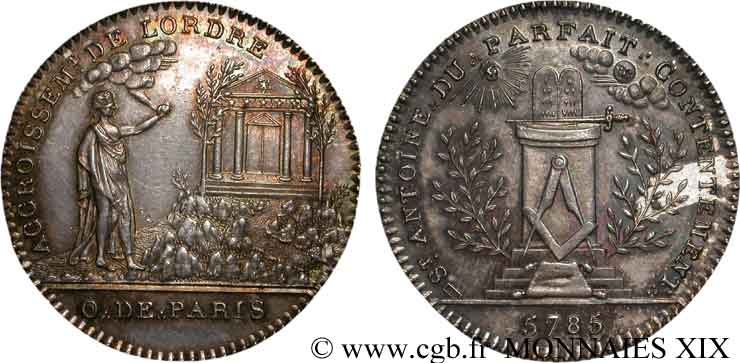
 Report a mistake
Report a mistake Print the page
Print the page Share my selection
Share my selection Ask a question
Ask a question Consign / sell
Consign / sell
 Full data
Full data
